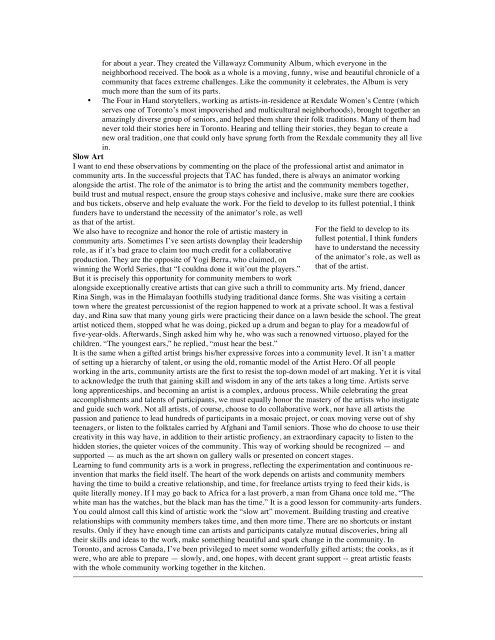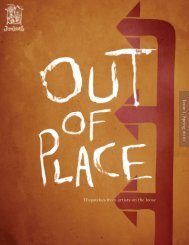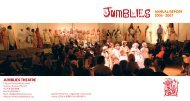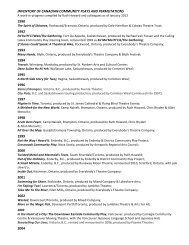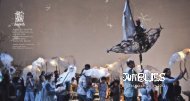Click here for PDF - Jumblies Theatre
Click here for PDF - Jumblies Theatre
Click here for PDF - Jumblies Theatre
Create successful ePaper yourself
Turn your PDF publications into a flip-book with our unique Google optimized e-Paper software.
<strong>for</strong> about a year. They created the Villawayz Community Album, which everyone in the<br />
neighborhood received. The book as a whole is a moving, funny, wise and beautiful chronicle of a<br />
community that faces extreme challenges. Like the community it celebrates, the Album is very<br />
much more than the sum of its parts.<br />
• The Four in Hand storytellers, working as artists-in-residence at Rexdale Women’s Centre (which<br />
serves one of Toronto’s most impoverished and multicultural neighborhoods), brought together an<br />
amazingly diverse group of seniors, and helped them share their folk traditions. Many of them had<br />
never told their stories <strong>here</strong> in Toronto. Hearing and telling their stories, they began to create a<br />
new oral tradition, one that could only have sprung <strong>for</strong>th from the Rexdale community they all live<br />
in.<br />
Slow Art<br />
I want to end these observations by commenting on the place of the professional artist and animator in<br />
community arts. In the successful projects that TAC has funded, t<strong>here</strong> is always an animator working<br />
alongside the artist. The role of the animator is to bring the artist and the community members together,<br />
build trust and mutual respect, ensure the group stays cohesive and inclusive, make sure t<strong>here</strong> are cookies<br />
and bus tickets, observe and help evaluate the work. For the field to develop to its fullest potential, I think<br />
funders have to understand the necessity of the animator’s role, as well<br />
as that of the artist.<br />
We also have to recognize and honor the role of artistic mastery in<br />
community arts. Sometimes I’ve seen artists downplay their leadership<br />
role, as if it’s bad grace to claim too much credit <strong>for</strong> a collaborative<br />
production. They are the opposite of Yogi Berra, who claimed, on<br />
winning the World Series, that “I couldna done it wit’out the players.”<br />
But it is precisely this opportunity <strong>for</strong> community members to work<br />
For the field to develop to its<br />
fullest potential, I think funders<br />
have to understand the necessity<br />
of the animator’s role, as well as<br />
that of the artist.<br />
alongside exceptionally creative artists that can give such a thrill to community arts. My friend, dancer<br />
Rina Singh, was in the Himalayan foothills studying traditional dance <strong>for</strong>ms. She was visiting a certain<br />
town w<strong>here</strong> the greatest percussionist of the region happened to work at a private school. It was a festival<br />
day, and Rina saw that many young girls were practicing their dance on a lawn beside the school. The great<br />
artist noticed them, stopped what he was doing, picked up a drum and began to play <strong>for</strong> a meadowful of<br />
five-year-olds. Afterwards, Singh asked him why he, who was such a renowned virtuoso, played <strong>for</strong> the<br />
children. “The youngest ears,” he replied, “must hear the best.”<br />
It is the same when a gifted artist brings his/her expressive <strong>for</strong>ces into a community level. It isn’t a matter<br />
of setting up a hierarchy of talent, or using the old, romantic model of the Artist Hero. Of all people<br />
working in the arts, community artists are the first to resist the top-down model of art making. Yet it is vital<br />
to acknowledge the truth that gaining skill and wisdom in any of the arts takes a long time. Artists serve<br />
long apprenticeships, and becoming an artist is a complex, arduous process. While celebrating the great<br />
accomplishments and talents of participants, we must equally honor the mastery of the artists who instigate<br />
and guide such work. Not all artists, of course, choose to do collaborative work, nor have all artists the<br />
passion and patience to lead hundreds of participants in a mosaic project, or coax moving verse out of shy<br />
teenagers, or listen to the folktales carried by Afghani and Tamil seniors. Those who do choose to use their<br />
creativity in this way have, in addition to their artistic profiency, an extraordinary capacity to listen to the<br />
hidden stories, the quieter voices of the community. This way of working should be recognized — and<br />
supported — as much as the art shown on gallery walls or presented on concert stages.<br />
Learning to fund community arts is a work in progress, reflecting the experimentation and continuous reinvention<br />
that marks the field itself. The heart of the work depends on artists and community members<br />
having the time to build a creative relationship, and time, <strong>for</strong> freelance artists trying to feed their kids, is<br />
quite literally money. If I may go back to Africa <strong>for</strong> a last proverb, a man from Ghana once told me, “The<br />
white man has the watches, but the black man has the time.” It is a good lesson <strong>for</strong> community-arts funders.<br />
You could almost call this kind of artistic work the “slow art” movement. Building trusting and creative<br />
relationships with community members takes time, and then more time. T<strong>here</strong> are no shortcuts or instant<br />
results. Only if they have enough time can artists and participants catalyze mutual discoveries, bring all<br />
their skills and ideas to the work, make something beautiful and spark change in the community. In<br />
Toronto, and across Canada, I’ve been privileged to meet some wonderfully gifted artists; the cooks, as it<br />
were, who are able to prepare — slowly, and, one hopes, with decent grant support -- great artistic feasts<br />
with the whole community working together in the kitchen.


